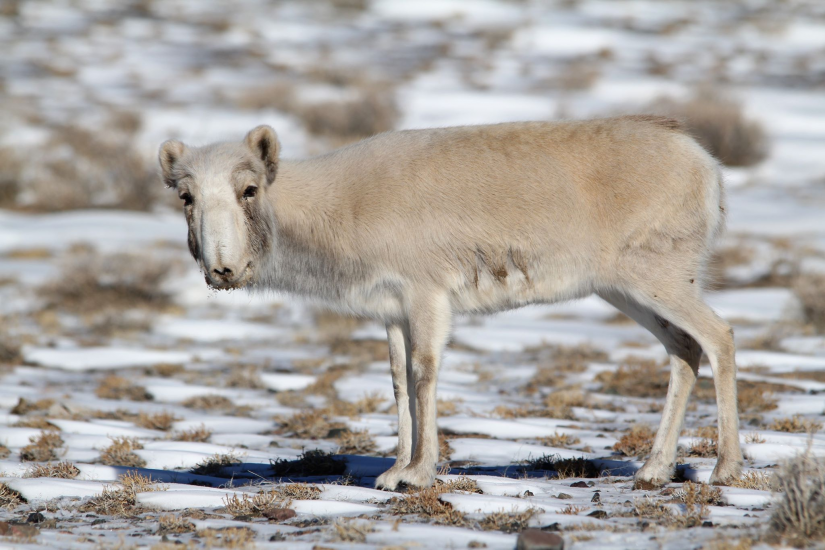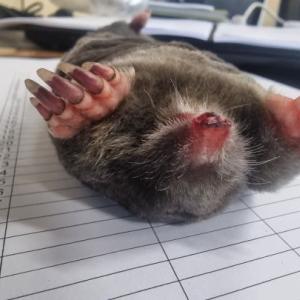Ancient species tracing back to the Ice Age
The Mongol Messenger
Ulaanbaatar /MONTSAME/.
The hot, blazing sun shines upon the Khuisiin Gobi, with the mirage in its full glory. Every now and then, shrubs and tumbleweed as well as various other plants that I do not know the name of would be seen in the far distance as the only sound that surrounds us is those of sand and rocks weathered by centuries of wind beneath our feet. Just right then, a person I was together with on this journey said, “There is a saiga antelope galloping over there.” As I squint in the direction he pointed, there was nothing to be seen except a trail of white dust. As I said, “I lost my chance to see the rare animal,” others in the car said, “It is fine to only see its trail. The saiga antelope is a very fast animal, so it is already difficult enough to properly spot them.”
The World Wide Fund for Nature (WWF) conducted a research using the internationally recognized line transect method in the habitats of the Mongolian saiga antelope - the Shargiin Gobi, Khuisiin Gobi, Durgun steppe, Mankhan soum of Khovd aimag, Zavkhan soum of Uvs aimag, Durvuljin soum of Zavkhan aimag. In 2018 alone, due to various factors such as food shortage, harsh weather conditions, and sheep and goat plague, the population of the saiga antelope had decreased to about 3,800. However, their numbers have increased to about 5,070 according to a population assessment conducted in January 2020.
As of today, there are only two subspecies of the saiga antelope in the world: the ‘Saiga Tatarica’ commonly known as the alert antelope, and the ‘Saiga Tatarica Mongolica’ - the Mongolian saiga antelope. And it is for that exact reason that the saiga antelope is considered as one of the ‘Great Gobi 6’ alongside the wild bactrian camel, ‘Mazaalai’ Gobi bear, ‘Khulan’ or wild ass, goitered gazelle, and ‘Takhi’ or wild horse, all of which having important roles in the Gobi ecosystem.
Scholars and researchers have all agreed that the Mongolian saiga antelope was an ancient species that traces back to the Ice Age alongside the woolly mammoth, woolly rhinoceros, and saber-toothed tiger. The species is believed to have been living from 250 thousand years ago.
THE EMPHASIS - ‘MONGOLIAN’

In 2007, a genetic research was conducted on the coat and hair of the Mongolian saiga antelope, which defined the saiga antelope as a subspecies of the saiga antelope in Kazakhstan rather than an independent species. However, some researchers were opposed to the statement. In general, it is apparent that there had been many difficulties in accurately defining the classification of the saiga antelope.
Russian researcher A.G.Bannikov initially defined the Mongolian saiga antelope as an independent species named ‘Saiga mongolica’ based on the difference in hair color, horn size, body shape, and skull measurement in 1946. Not long after however, the researcher withdrew his conclusion, and put the saiga antelope under the subspecies, ‘Saiga imberbic mongolica’. Afterwards, other research works were conducted on the matter by various scholars that do not all need to be mentioned. This is due to an international conference organized in Ulaanbaatar city in 2010, with representatives of all Governments with saiga antelopes in their territory, science sector, and international and non-governmental organizations. During the conference, the Mongolian saiga antelope was acknowledged as an independent species and the sides renewed their agreement. And that was how the galloping saiga antelope - one of the gems of the Mongolian Great Gobi received the acknowledgement of scholars.

About this matter, we interviewed researcher at the Wildlife Conservation Society, biologist B.Buuveibaatar.
-Most researchers consider the Mongolian saiga antelope as an independent species. However, the animal continues to be considered as a subspecies of the saiga antelope in Kazakhstan by some. What are your thoughts on the matter?
-The classification issue of the saiga antelope has yet to be solved completely. It continues to create debate. Some researchers consider the antelope as two subspecies, while others continue to express that they are two independent species. However, based on the research done by many researchers throughout the years, scholars in the scene have recently begun to agree that there are two different species: the alert saiga antelope and the Mongolian saiga antelope.
-What are the requirements to define an animal as an independent species?
-There are many criteria. The animal is considered for their geographical distribution as well as morphology. Genetic research is also conducted to make a final decision. For its geographical distribution, the Mongolian saiga antelope is apparent that it is a separate, independent species from the saiga antelope in Kazakhstan. The same conclusion can also be found for its morphology. For instance, the Mongolian saiga antelope fawn weighs 2.5 kg, while the saiga antelope in Kazakhstan weighs 3.5 kg, which is a large difference.
-I have also heard that it is a significant factor in assessing ecosystem health. Could you elaborate on this matter?
-The survival of the Mongolian saiga antelope through the Ice Age is crucial in assessing the ecosystem health of the semi-arid desert areas of Mongolia. This is due to the continued existence of the saiga antelope serving as proof of maintained ecological balance in the Gobi and desert.
-There are several reasons that caused the decrease in saiga antelope population. What measures are being taken against these causes?
-The initial reason for the saiga antelope population to decrease is related to the animal’s horns. This is due to the horns being commonly used for medicine in traditional Chinese medical practices as well as its perceived assumption of reducing fevers. Thus, poaching had a significant effect on the saiga antelope population to decrease. Furthermore, there are natural factors, such as cold weather and predator animals. It should also be mentioned that the saiga antelope being infected by the first ever spread of sheep and goat plague in Mongolia was a cause for the major decrease in their population in 2017. Today however, the factor with the highest risk is the overpopulation of livestock in the saiga antelope habitat areas. The latest research showed that there are over 5,000 saiga antelopes in Mongolia. But this is a number that equals the amount of livestock owned by a single Herder of Thousand Head of Livestock. Thus, a management regulation is necessary for herders to give more significance to the livestock quality rather than sheer numbers.
In aims of reducing the risks endangering the Mongolian saiga antelope, NGOs for environmental protection and the WWF Mongolia are regularly organizing promotional campaigns about the saiga antelope for the public as well as research in its habitat. Moreover, special clubs have been established to promote the animal to school children in soums where saiga antelopes graze in large groups. One of the most recent promotional campaigns being organized for the public through social media is the ‘Bukhundei’ campaign implemented by WWF Mongolia.

-A study has shown that over 70 percent of the saiga antelope delivered twin offspring last year. You have also conducted a research on the antelope offspring. Could you tell us more about this?
-It is common for the saiga antelope to deliver twin offspring, but their delivery is dependent on the weather conditions of that time. In a year with plenty of food, warm temperatures, and pleasant conditions, twin offsprings are delivered. On the other hand, in years with scarce food and cold weather, it is uncommon for twin offspring to be delivered, and more likely for their population to decrease. According to studies, the likelihood of the saiga antelope’s delivery of twin offspring is 20 percent at minimum, and 80 percent at maximum. The amount of fawns delivered as well as their mortality is studied each year. In most cases, only about 50 percent of the newborn fawns are able to join their herd. The rest become prey for carnivorous birds and other predatory animals.

-One of the three gazelle species in Mongolia is the saiga antelope. What are the unique features of the animal compared to the other gazelle species?
-Yes, there are three species of gazelle in Mongolia: the Mongolian gazelle, the goitered gazelle, and the Mongolian saiga antelope. The saiga antelope is unique from other gazelles for two features. One would be its appearance - its big nose as well as ears. The second feature is its unique “personality”. Instead of leaping or galloping like other gazelles, the saiga antelope trots when running away from various animals. This shows that the animal is quite different from the rest of the hoofed animals.
A STORY TO BE TOLD ALONGSIDE THE SAIGA ANTELOPE

In the late 60s and early 70s, an idea to newly relocate the Mongolian saiga antelope to its original habitat was initiated by professor, Dr. S.Dulamtseren, who made highly valued contributions to the research and protection of endangered animals during his time working as the Head of the Mammalian Ecology Laboratory of the Institute of Biology at the Mongolian Academy of Sciences (MAS). At the time, the herds of saiga antelope were counted at only several hundreds--and even only a few dozen in some parts of the country. It was frequently highlighted that the species was on the brink of extinction if proper research and breeding is not done. Thus, the relocation of saiga antelopes first began in the 1970s, with the participation of saiga antelope researchers from Russia as well. We asked a few questions about the matter from Mongolian saiga antelope researcher, Dr. L.Amgalan, a student of Dr. S.Dulamtseren who was personally involved in the initial efforts to relocate the animal.
Around the time when Dr. L.Amgalan began his career as a researcher at MAS shortly after his graduation from the National University of Mongolia in 1979, it used to be specifically instructed by the state to research rare and endangered animals in intervals of 5 years. In 1988, he and his research team went on a journey to the Gobi region to conduct research on the rare animals in the Gobi.

Article 2V of the 1st resolution of the Ministerial Committee on ‘Some measures to protect wildlife and resources and regulate hunting’ from 1979 stated, “...relocation of rare and endangered animals such as the saiga antelope to be planned and organized.” Thus, scholars were obliged to relocate the saiga antelope and begin conducting research on the matter. The research team consisted of Dr. S.Dulamtseren, associate scholar of the then joint Mongolian-Soviet biological field research class G.N.Sapozhnikov, specialist at the Great Gobi Strictly Protected Area J.Badamkhand, S.Purevdorj, and Dr. L.Amgalan.
And that began the activities to raise saiga antelope fawns in Bayanbulag soum of Gobi-Altai aimag. According to various studies, only about 50 percent of the newborn fawns join the herd, increasing the population. The rest is faced with natural selection, either becoming prey for predatory animals or dying due to illnesses. The team of researchers gathered a total of 102 fawns during the years of 1985-1989. In other words, they captured and relocated an average of 10-12 fawns in a year. Although Mongolians had raised wild animals from ancient times, it is said that raising and taking care of the animals were quite challenging at the start. Despite having water inflow as well as plenty of green space in the large fence, newborn fawns would injure their head or body by running into the fence, or catch various illnesses. Fortunately, injections and vaccines were able to fully prevent the fawns from getting sick.

The saiga antelope fawns used to be breastfed by goats, with the help of local herders. The idea is said to have been suggested by the herders themselves. And it was successfully implemented. At first, the fawns would be evaded but eventually the goats become accustomed to them. Herders are able to tell if livestock offspring are full or not by touching their stomach area. Researchers used the same method to check the fawns. Five years later, there were no mortality recorded for the fawns.
Afterwards, a total of 54 saiga antelopes were released in the sites of Zahui and Bayanbulag in Gobi-Altai aimag. Once they were able to reproduce on their own, they stopped relocating fawns from Shargiin Gobi. Coincidentally, major changes were being made in the country’s political status from the 90s, which caused further relocating activities to stop due to financial issues. Nevertheless, Mongolian scholars organizing the work that kicked off with the participation of Russian researchers showed our own faults and achievements. However in the end, the achievements were significantly more as it proved that the Mongolian saiga antelope raised by specialists were able to reproduce in both sheltered areas and out in nature.
DUTIES AND RESPONSIBILITIES

I mentioned that the Mongolian saiga antelope population has increased to about 5,070 at the start of the article. However, it must be highlighted once more that the number is about the same amount of livestock owned by a Herder of Thousand Head of Livestock. For this reason, the entire population is in high risk of going extinct due to extreme weather conditions such as dzud or spread of an infectious disease. Moreover, illegal hunting continues to exist...
Although the animal frequently changes its pasture looking for only the best grass to eat, they are unique for not migrating very far. It is also quite strange how the saiga antelope becomes a herd of no less than 50 in the Shargiin Gobi during winter, but goes their separate ways once the weather is warmer. Herders perceive this act incorrectly and consider the saiga antelope as “an animal that destroys pasture”, which significantly affects the growth of the Mongolian saiga antelope population, highlighted researcher B.Buuveibaatar. A study has found that the animal feeds on about 28-30 different species of plants. The plants they mainly feed on include grass, wild leek, and anabasis, but their choice highly depends on the state of the season. In other words, there are times when the plants being eaten by livestock are different from those being eaten by the saiga antelope. For instance, while herd animals do not feed on a type of anabasis at its certain height of quality, antelopes prefer to feed on them during that time. In general, the time has come where we must fully consider whether it is right to be fighting over pasture with wild animals.
For Mongolia, one of the oldest living species still around today is the Mongolian saiga antelope. Furthermore, the saiga antelope is such a rare animal that it is found nowhere else other than the Mongolian Gobi. This species that have gone through natural selection and the Ice Age should not go extinct as a result of our wrongdoings. It is one case for us to be saying, “Mongolian saiga antelope should not go extinct.” But it would be entirely different if each and every one of us participates in saiga antelope protection activities and promotes the species to the public.

The reasons causing the saiga antelope population to decrease has yet to be fully dealt with. Thus, researchers continue to highlight that actions must be taken despite the good news of increase in their population. Poaching, overpopulation of livestock and overgrazing, extreme weather conditions, and infectious diseases--there are many factors that endanger the Mongolian saiga antelope. And it is for that exact reason that scholars conclude that relocation and creation of several independent groups of population could lower the risks of draught and dzud, food shortage, and infectious diseases. Measures such as putting the areas where saiga antelopes reproduce and deliver offspring under state special protection, and implementing effective works to reduce poaching are ways to protect the Mongolian saiga antelope found nowhere else in the world from extinction.
B.Altankhuyag
 Ulaanbaatar
Ulaanbaatar














































































